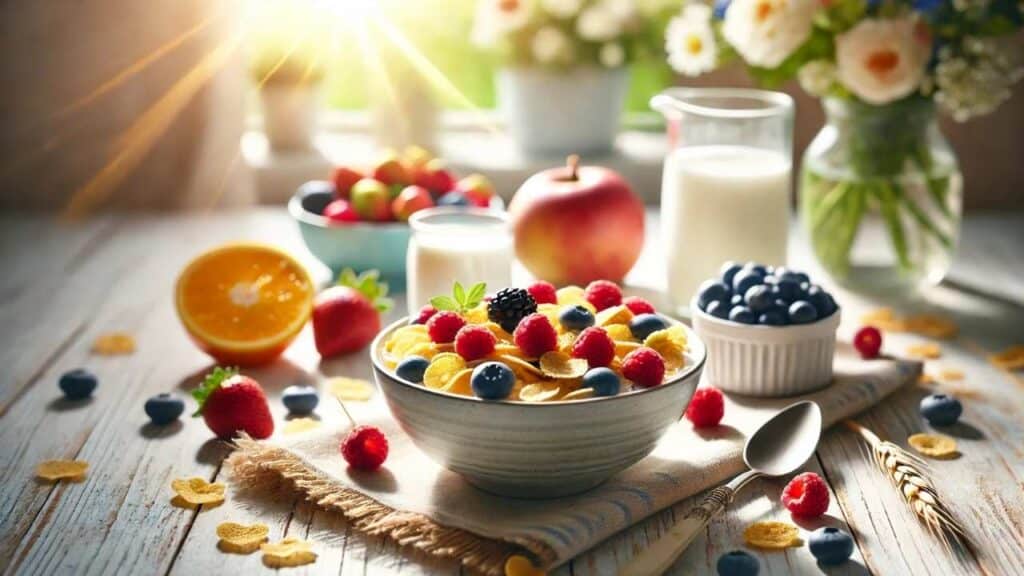Is your morning cereal as healthy as you perceive it to be? Experts Thoughts

That colorful cereal box promising “whole grains” and “essential vitamins” might be hiding a sugary secret. Many breakfast cereals marketed as healthy choices are actually loaded with hidden sugars, artificial additives, and refined carbs that sabotage your energy levels and long-term health.(Healthline)
I’ve seen countless clients, like Amanda, a busy mom who thought her “heart-healthy” cereal was a smart choice until her blood sugar levels told a different story. Let’s uncover what really goes into your morning bowl and how to make better choices without sacrificing convenience.
Related: Nutritional Value of Meat Ribs: Are Meat Ribs a Good Meal After Workouts?
The Sugar Trap: What’s Really in Your Cereal?
“Healthy” cereals often contain more sugar per serving than a glazed donut. A 2024 study in Nutrition Journal found that 76% of cereals marketed to adults exceed the WHO’s daily added sugar recommendation (6 tsp) in just one serving.
What You’re Not Seeing on the Label:
- Clever marketing terms: “Made with whole grains” ≠ 100% whole grain
- Hidden sugar aliases: Malt syrup, “fruit concentrate,” and organic cane sugar are still sugar
- Portion distortion: A “serving size” may be just ¾ cup (who eats that little?)
Case Study: *Mark, a fitness enthusiast, was shocked when I showed him his “protein-fortified” cereal had 14g of sugar, more than his post-workout shake.*
The Fiber Illusion: Why “Whole Grain” Claims Can Mislead
Not all fiber is created equal. Many cereals use isolated fibers (like chicory root) to inflate numbers without the benefits of real whole grains.
What Research Shows (2025):
- A Journal of Food Science study found synthetic fibers don’t feed gut bacteria like natural sources (oats, bran).
- “High fiber” cereals often lack protein/fat, causing blood sugar spikes despite the fiber claim.
Pro Tip: Look for cereals with:
5g+ naturally occurring fiber (from whole oats, wheat, or bran)
<5g added sugar (check ingredients, not just “sugar” line)
3g+ protein to balance blood sugar
The Additive Problem: Preservatives and “Health Halo” Ingredients
“Fortified with vitamins!” sounds great, but your body may not absorb them well from processed cereal.
Common Culprits:
- Tocopherols (synthetic vitamin E): Linked to inflammation in high doses (NIH, 2023)
- BHT/BHA: Preservatives banned in the EU but still in US cereals
- “Natural flavors”: Often code for lab-created enhancers
Expert Quote:
“Fortified cereals are like putting premium fuel in a leaky tank, if your gut health is poor, you won’t absorb those synthetic nutrients.” (Dr. Priya Sharma, gastroenterologist) (HealthLine, 2024)
How to Choose a Truly Healthy Cereal (Step-by-Step)
Step 1: Flip the Box & Read This First
- Ingredients list > Nutrition Facts: If sugar is in the top 3, skip it.
- Avoid these: “Enriched flour,” “hydrogenated oils,” “caramel color”
Step 2: The 5:5:5 Rule
- <5g sugar
- >5g fiber
- >5g protein
Step 3: Upgrade Your Bowl
- Add nuts/seeds for healthy fats
- Top with Greek yogurt for protein
- Use unsweetened almond milk to avoid hidden sugars
Better Alternatives:
- Plain oatmeal with cinnamon & berries
- DIY granola (recipe below)
- Savory breakfasts like eggs or avocado toast
What the Healthiest Breakfasts Have in Common
The best morning meals combine:
- Slow-digesting carbs (steel-cut oats, quinoa)
- Quality protein (eggs, yogurt, nut butter)
- Healthy fats (chia seeds, avocado)
1-Day Sample Plan:
- Busy mornings: Chia pudding (made overnight)
- Weekends: Veggie omelet with sweet potato hash
- Sweet tooth: Protein “cereal” (almonds, coconut flakes, dark chocolate)
Key Takeaways
“Low-fat” often means high-sugar, prioritize whole foods over processed claims
Fiber should come from real food, not lab-made additives
Pair carbs with protein/fat to avoid mid-morning crashes
Final Thought:
Not all cereals are created equal; understanding their nutritional content is key to making healthier choices.
While breakfast cereals can be part of a nutritious diet, it’s essential to be discerning. By selecting cereals with whole grains, low sugar, and high fiber, and by being mindful of portion sizes and added ingredients, you can enjoy a healthy start to your day.
“Your cereal shouldn’t need a mascot to sell its health benefits.”
Disclaimer:
It should be remembered that the information available at gymgoodies.net is constantly evolving and is up-to-date and authentic information on fitness, exercises, and health.
I am a veteran bodybuilder, considering I have been active in the industry for quite some time. I ensure that the content shared reflects the lessons I have learned in my years of training and working or all the exposure I have had.
That said, it must be understood that the information available on this portal is obtained through communication channels and is primarily for education and information. Some factors and changes occur, and the issues discussed in this website address such things.
Every piece of advice regarding fitness or health should be taken with caution.
You might need the assistance of fitness professionals, nutritionists, or doctors regarding your workout routine, diet, or fitness activity. Their advice should be personalized PPC, the guide you integrate into your routine, taking into account your specifications and requirements regarding your health and fitness.
This is key, considering our concern is your health and safety. Make sure you only use the data on the site to empower expert advice and nothing more.



